Nine years ago, Mauricio Pochettinho took charge of Tottenham Hotspur after a promising season with Southampton that saw the young manager guide the South Coast side to an eighth-place finish. In his inaugural season at Spurs, Pochettino would finish fifth but with fewer points than the side had managed to accrue in the previous season.
However, with young talent in the side, such as Christian Eriksen, Danny Rose and a relatively recent academy graduate named Harry Kane, it was clear that with some additional signings and more time for Pochettino to instil his philosophy, the North London club would become a force to be reckoned with.
A couple of years later, after Pochettino oversaw the addition of key players such as Dele Alli and Son Heung-min and a move away from White Hart lane, Spurs had solidified themselves as one of the best teams in the league.
The pinnacle of this ascension was, without a doubt, the UEFA Champions League final. After succumbing to a 2-0 loss to Liverpool in this final, it was evident in the following season that the loss had inflicted irreparable damage to the camp’s morale.
The subsequent four years saw Spurs adopt a win-now approach by bringing in the likes of José Mourinho and Antonio Conte to try and win silverware. However, with inconsistent results and mediocre performances, the wedge between the fans and the ownership has widened.
However, Ange Postecoglou’s appointment resembles Mauricio Pochettno’s, with the club committing to a project that will see them look to chase consistent progress rather than mainly prioritising silverware. Within this context, questions arise over whether Harry Kane, the side’s key player, will be willing to commit to this project at this stage of his career.
This scout report will provide an analysis and insight into what went wrong for Spurs last season and how Ange Postecoglou can help the side progress — with or without Harry Kane.
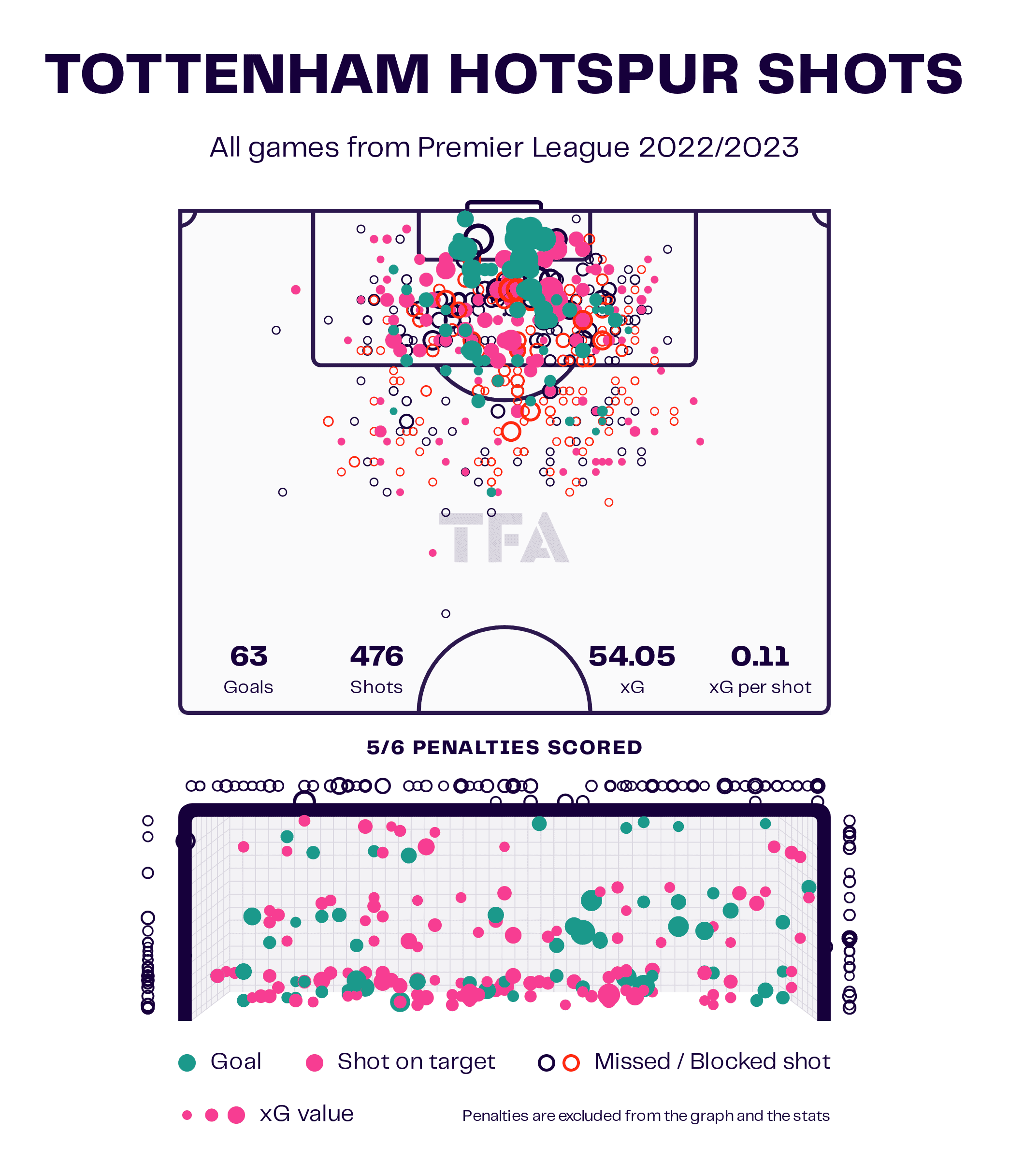
Last season, Tottenham scored 68 league goals in total (63 non-penalty goals), with Harry Kane scoring 30 of them. The next-highest scorer in the side was Heung-min Son with 10 and then Rodrigo Bentancur with five. Despite the lop-sided nature of the output, 68 goals was the joint-fifth-best tally in the league.
However, even if Kane departs, it is unlikely that Spurs will dip into the transfer market to replace the Englishmen, given that the side brought in Richarlison from Everton last season and will likely look to spread the goals between Dejan Kulusekvsi, James Maddison and Son.
However, even though these are talented players in their own right, it would still be challenging to spread the striker’s goal tally amongst them.
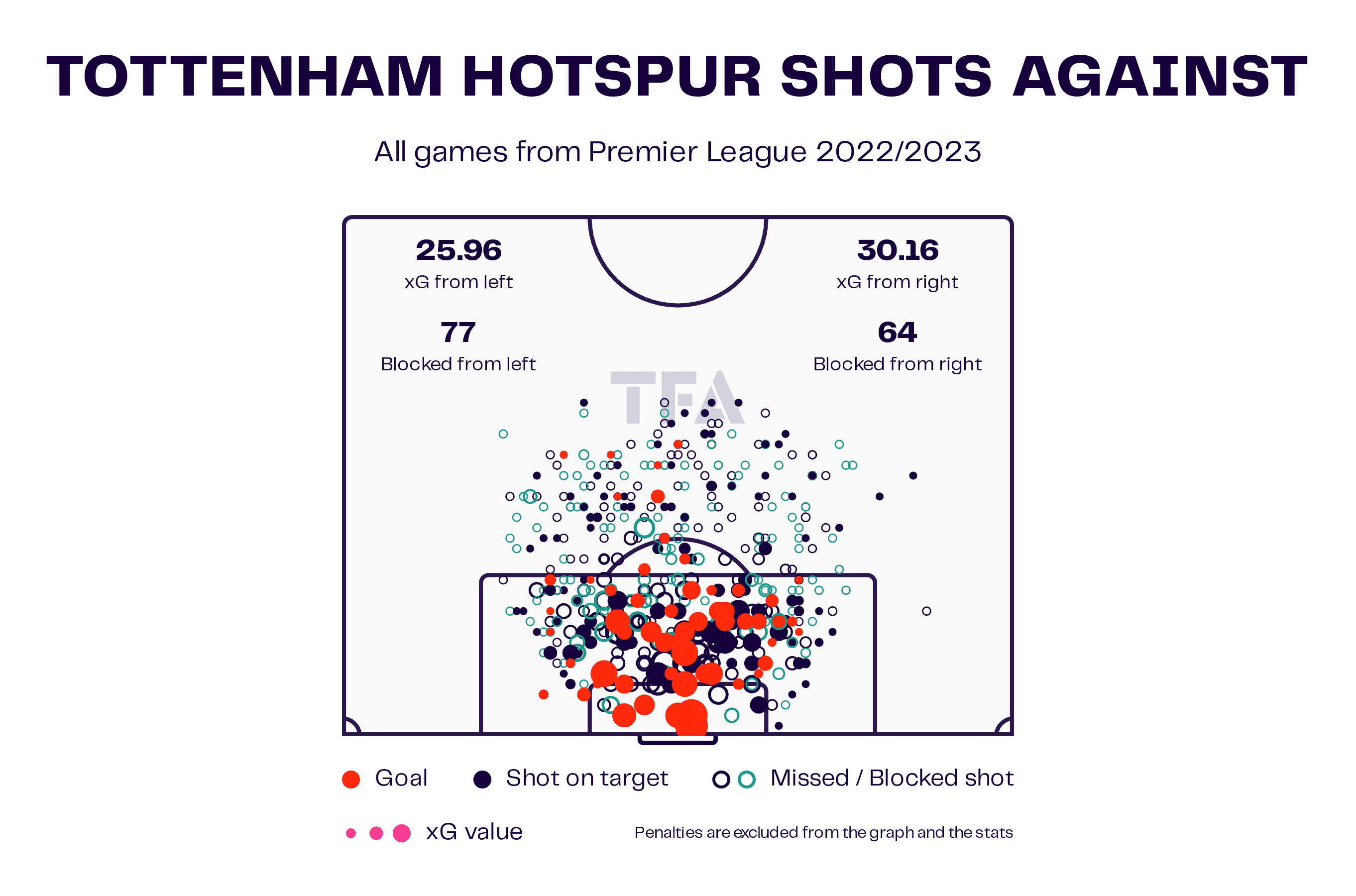
The most surprising element of Spurs’ 2022/23 season was their poor defensive record, which, given their rather impressive goal tally, cost them big time. Spurs conceded 63 goals from an xG against a figure of 56.12, which is a surprise because Antonio Conte has built a reputation over the last 10 years for building impregnable defences.
In this case, the side was poor for most of the last season. However, it must be examined whether or not this is only due to personnel issues or if wider tactical issues are evident in the side.
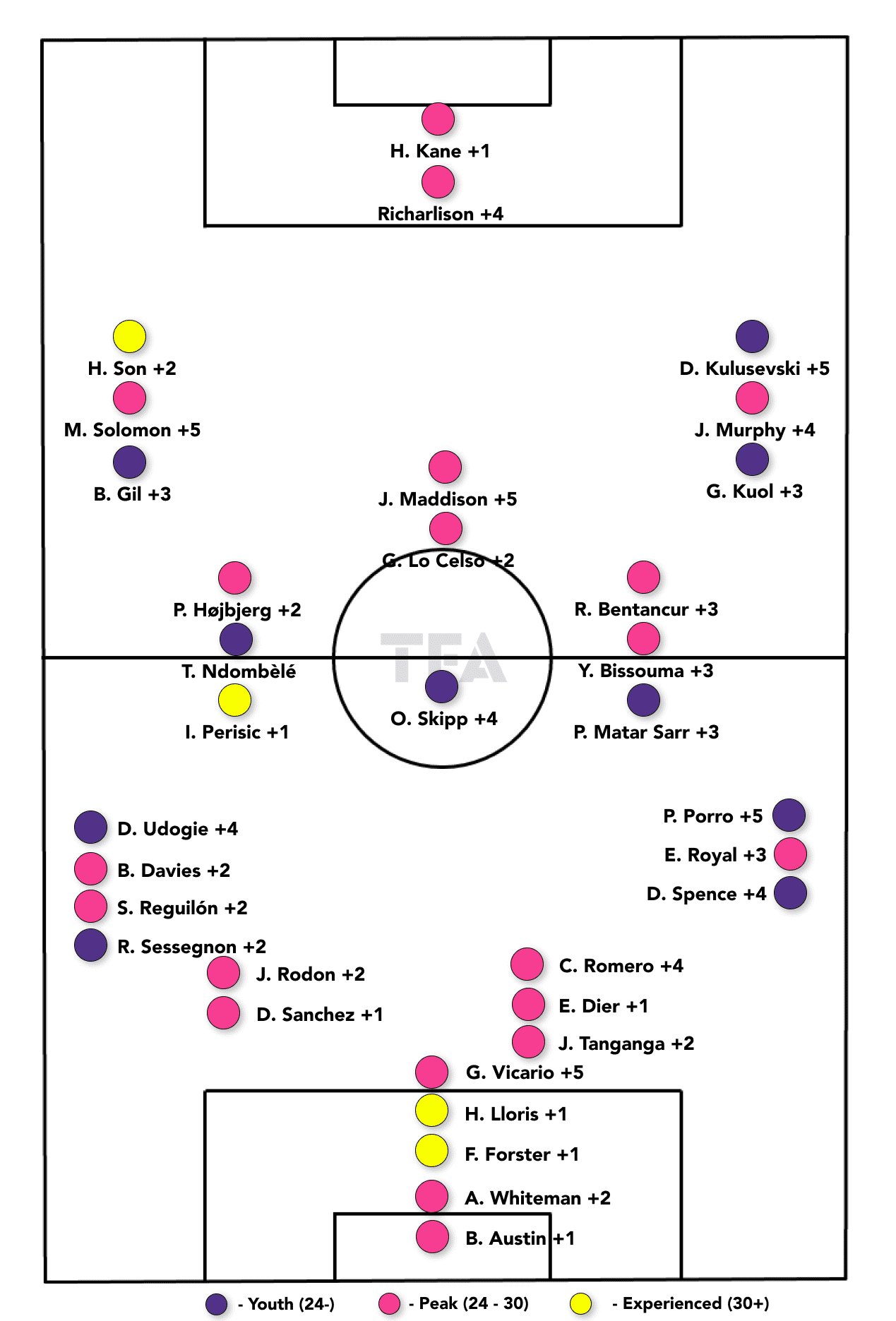
Compared to last season, Tottenham’s goalkeeping situation has undoubtedly improved. This is due to the incoming transfer of 26-year-old Guglielmo Vicario.
Although Hugo Lloris has been an excellent servant of the club, at 36, it appears that Spurs and the Frenchmen will part ways before the end of the summer. In the twilight of his career, Lloris had a save percentage of 67.5%.
From this perspective, Vicario could be a suitable replacement, with the Italian having a save percentage of 73.9. At the relatively young age of 26, he will likely be a cornerstone for the rebuild under Postecoglou.
Looking at wing-backs and midfielders, Spurs have a pool of players able to contribute now and develop in the future, with the promising Destiny Udogie in the left wing-back slot as well as players such as Ivan Perišić and Sergio Reguillon.
On the right-hand side, Djed Spence was never truly given a chance last season and will be desperate to prove his worth, with Pedro Porro also looking to make his Mark. From the perspective of their midfield, the addition of James Maddison can dove-tail nicely with the strengths of players such as Rodrigo Bentancur, Pierre-Emile Højbjerg, as well as Yves Bissouma and Oliver Skipp.
It will also be interesting to observe whether players such as Giovanni Lo Celso and Tanguy Ndombele will be given a chance to impress during pre-season.
Spurs‘ fundamental weakness from a depth and not quality perspective lies in their forward line and their centre-backs. Any injuries to starters, such as Dejan Kulusevski and the likes of Eric Dier, could seriously impact the side’s effectiveness.
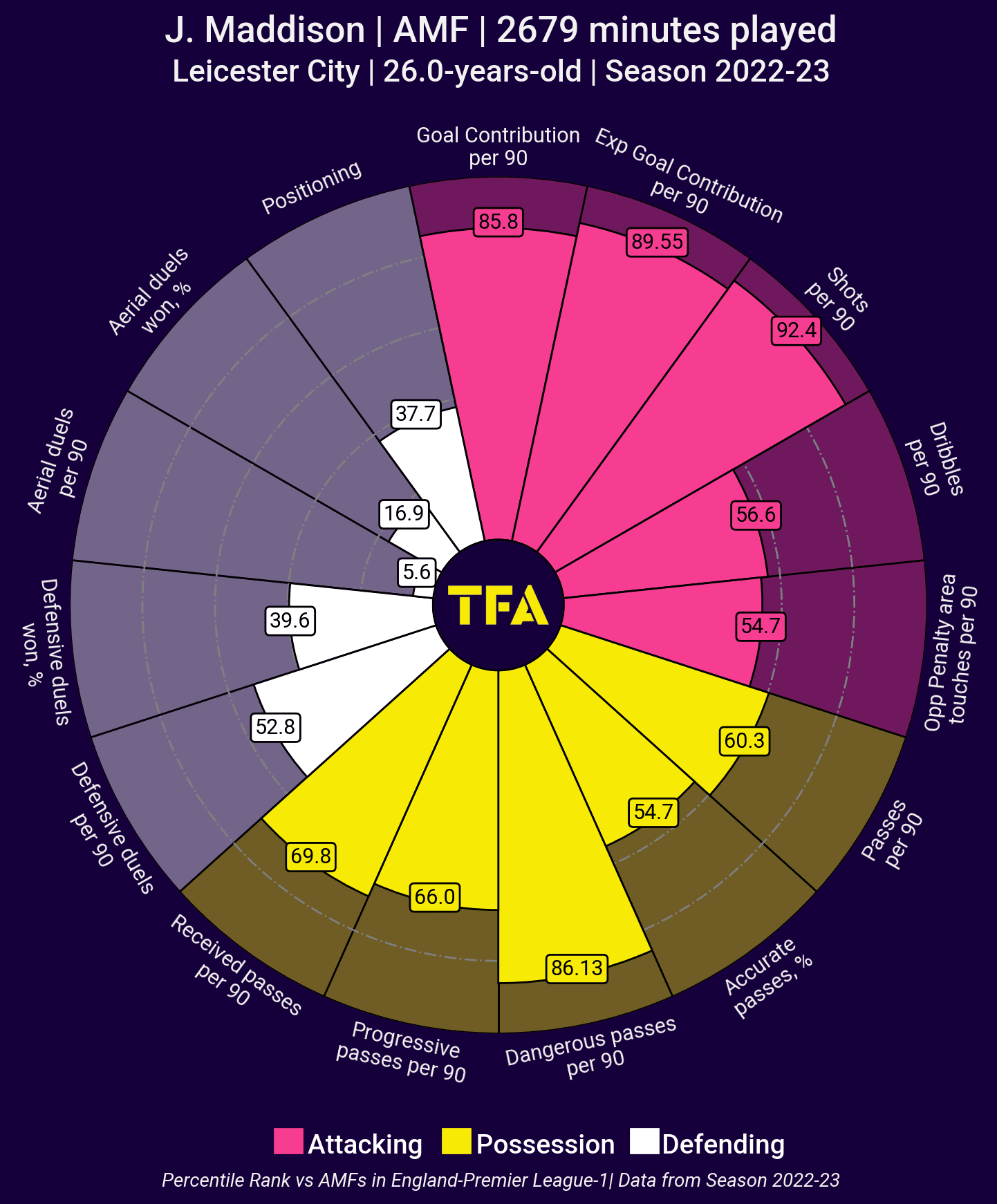
Despite Leicester’s relegation, James Maddison had an extraordinary season for the Foxes, finishing the campaign with 19 goal contributions. The midfielder had a total of five shot-creating actions per game as well as 5.48 progressive passes. Spurs will be able to use Maddison’s creative ability behind the opposition’s midfield line or in deeper areas as well.
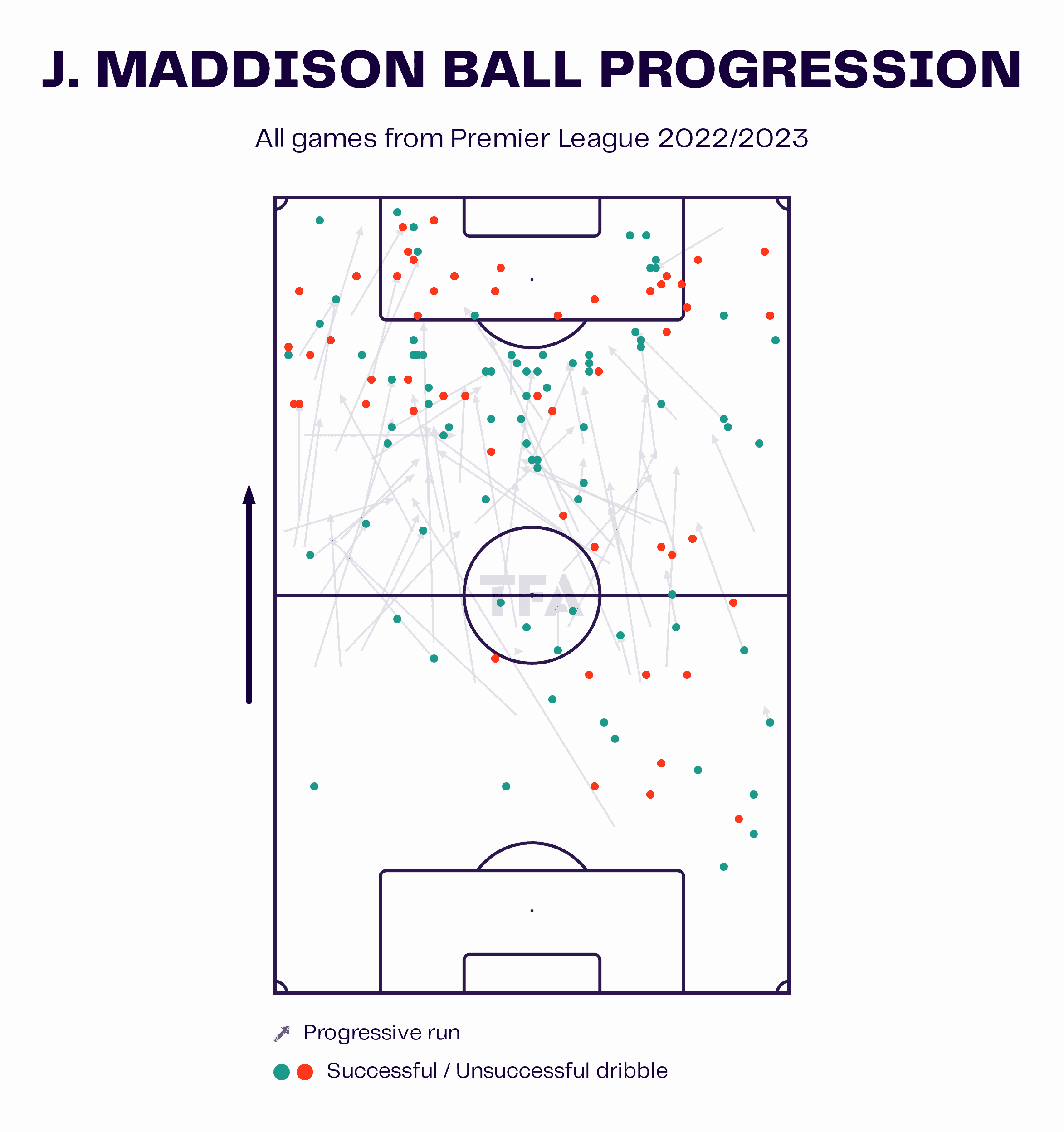
Attacking Phase
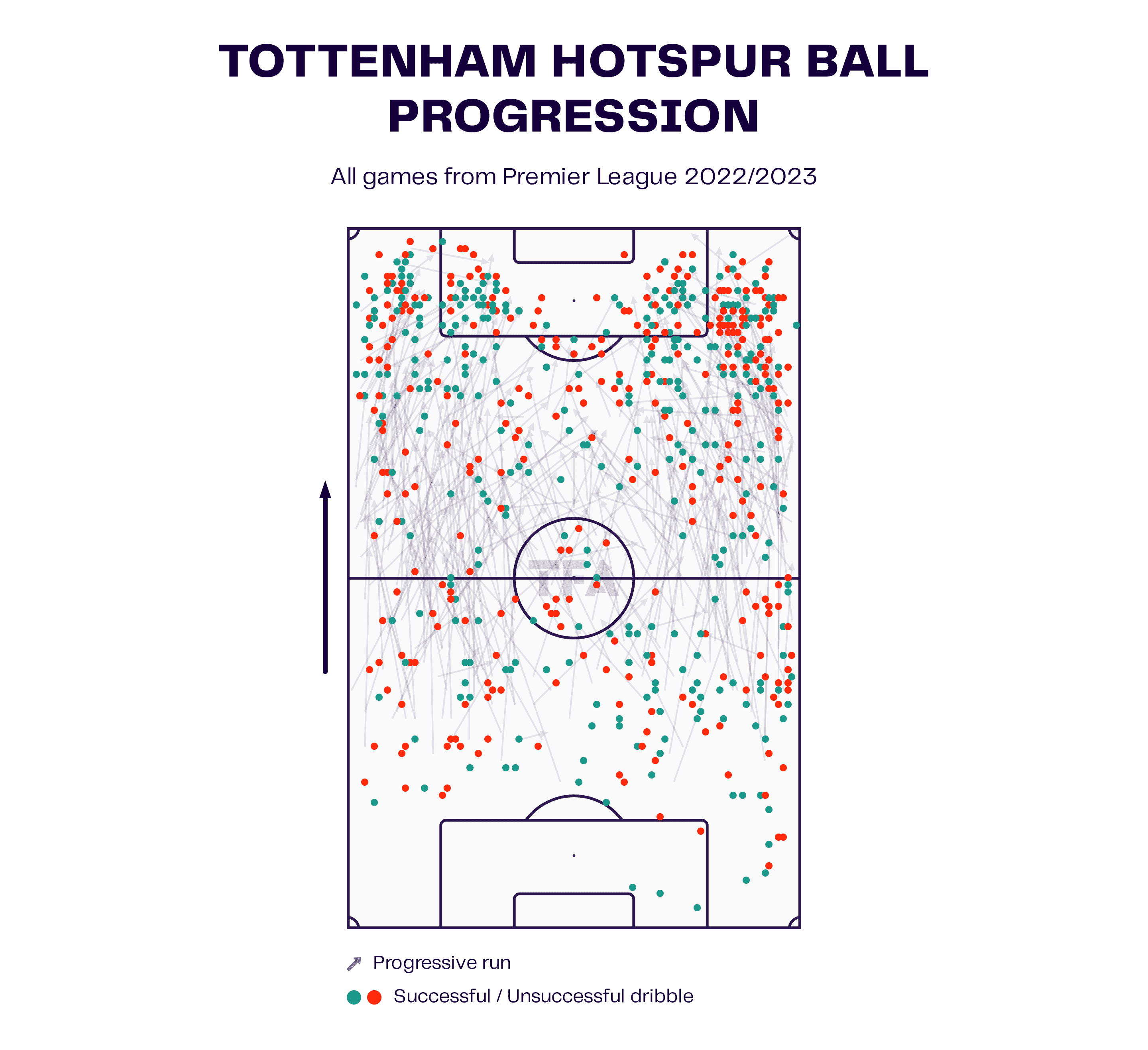
Tottenham’s attack last season was, ironically, centred around progressing the ball through the wide areas, with the side heavily relying on their wing-backs in each third of the pitch to advance the ball. Due to the side having an abundance of talent in the wing-back position, Postecoglou may opt to do the same.
This element of Conte’s game model has remained consistent throughout the last decade, with the Italian manager’s training regiment heavily relying on “automatisms” for his players to execute patterns of play through the wide areas quickly.
One particular pattern that occurred consistently was the wing-back advancing further up the pitch, whilst one of the strike pairings of Kane or Son would drop deeper. This can be seen in the example below, with Cristian Romero playing a pass to the dropping Son.
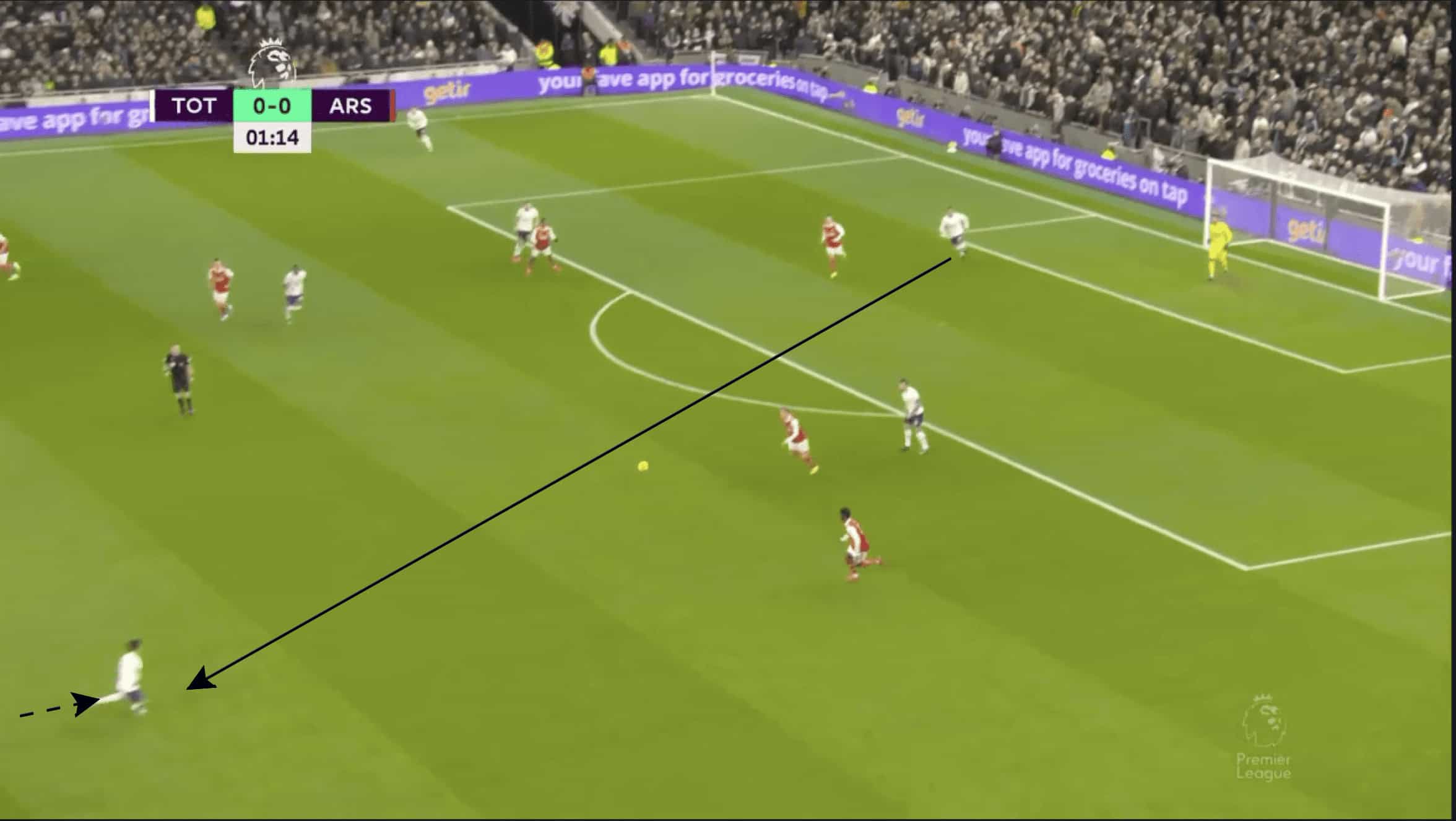
From this position, Ryan Sessegnon would begin to advance further up the pitch, with Son turning and playing a pass to the wing-back. In these scenarios, the remaining advanced players in the frontline would look to make attacking runs into the box.
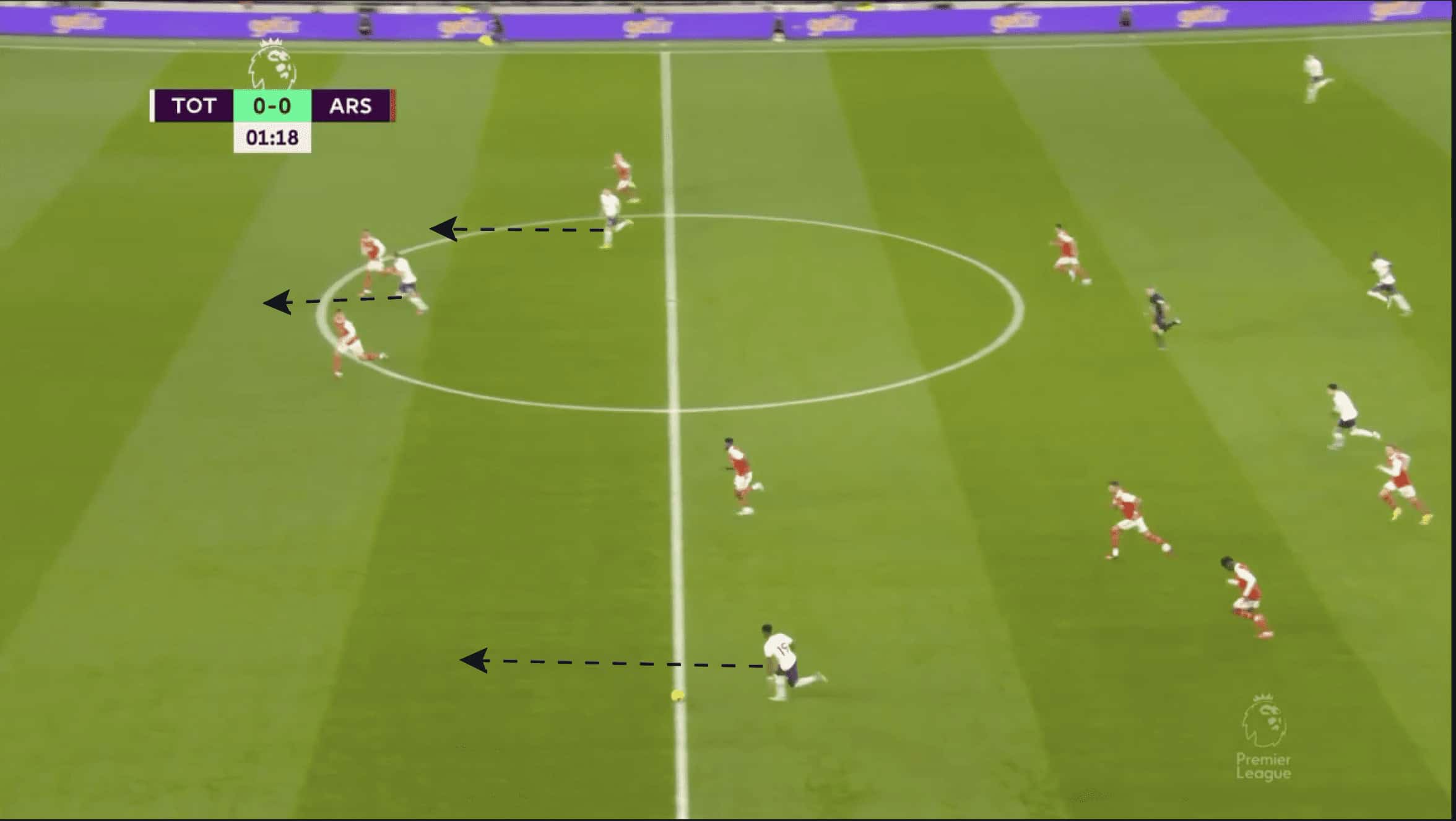
This pattern could take place from wider or central areas, with the image below providing an example of the same movement taking place, albeit this time from the centre. After Højbjerg receives the ball, he looks to play a pass to the dropping Son, who would then take a few touches before playing the ball to the left wing-back.
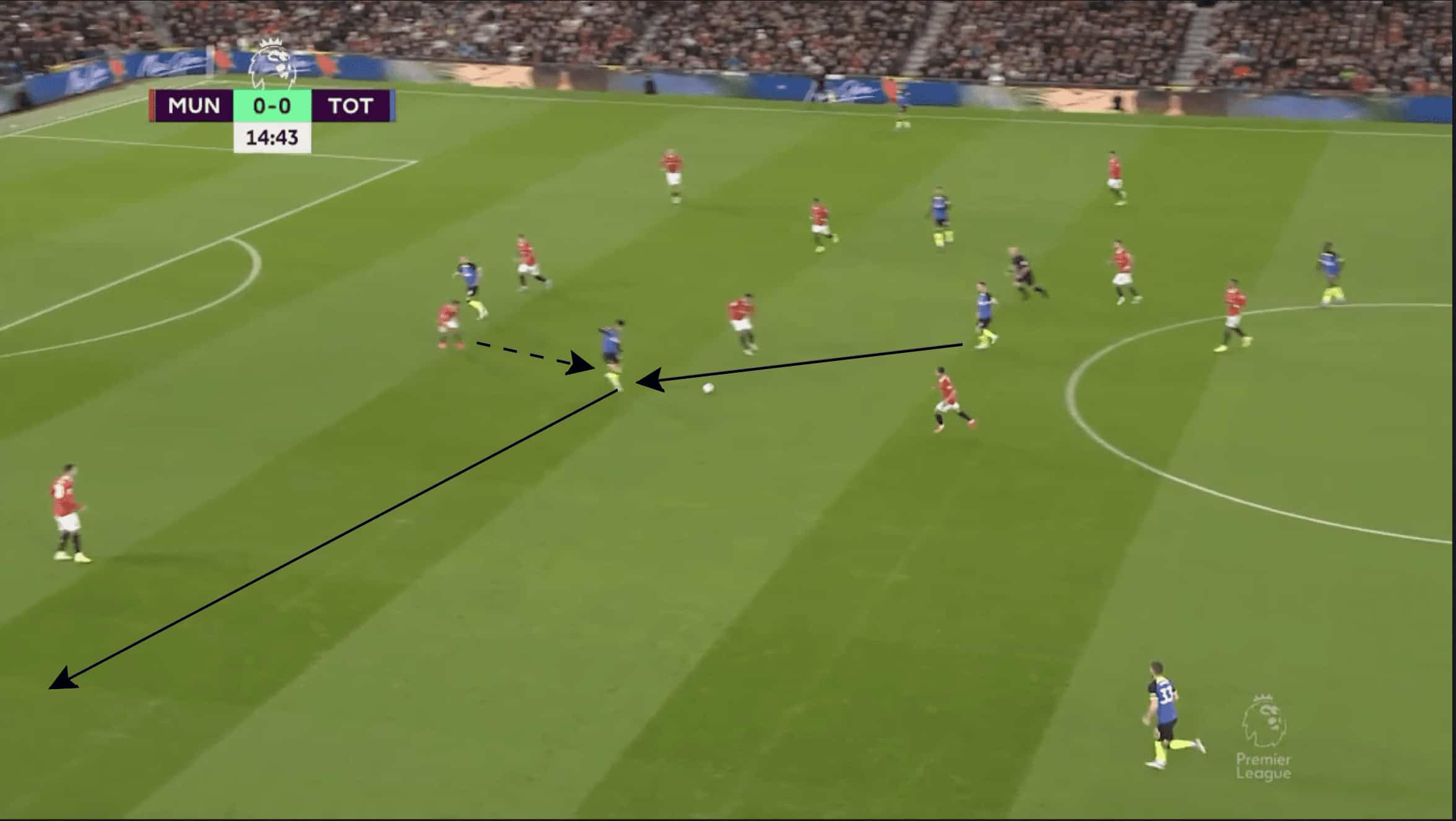
From these positions, it was not uncommon to see the left centre-back of the back three join in the attack. In this instance, Ben Davies provides an underlapping run, with Perišić playing a pass to the Welshman.
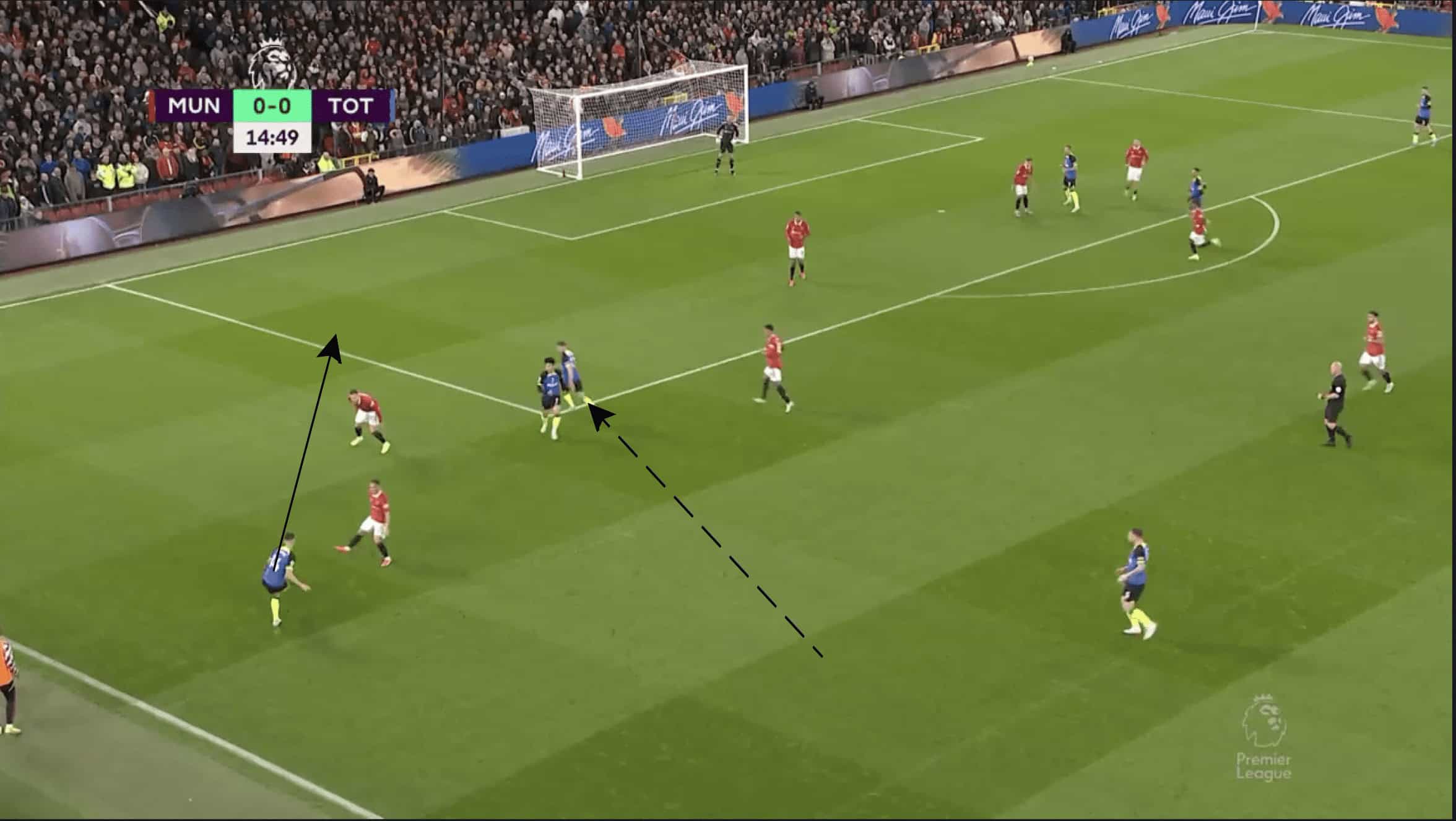
In the games where Clément Lenglet would play as the left centre-back, it was more unlikely to see him make underlapping runs. However, the centre-back would still advance into high positions enabling him to play deep crosses.
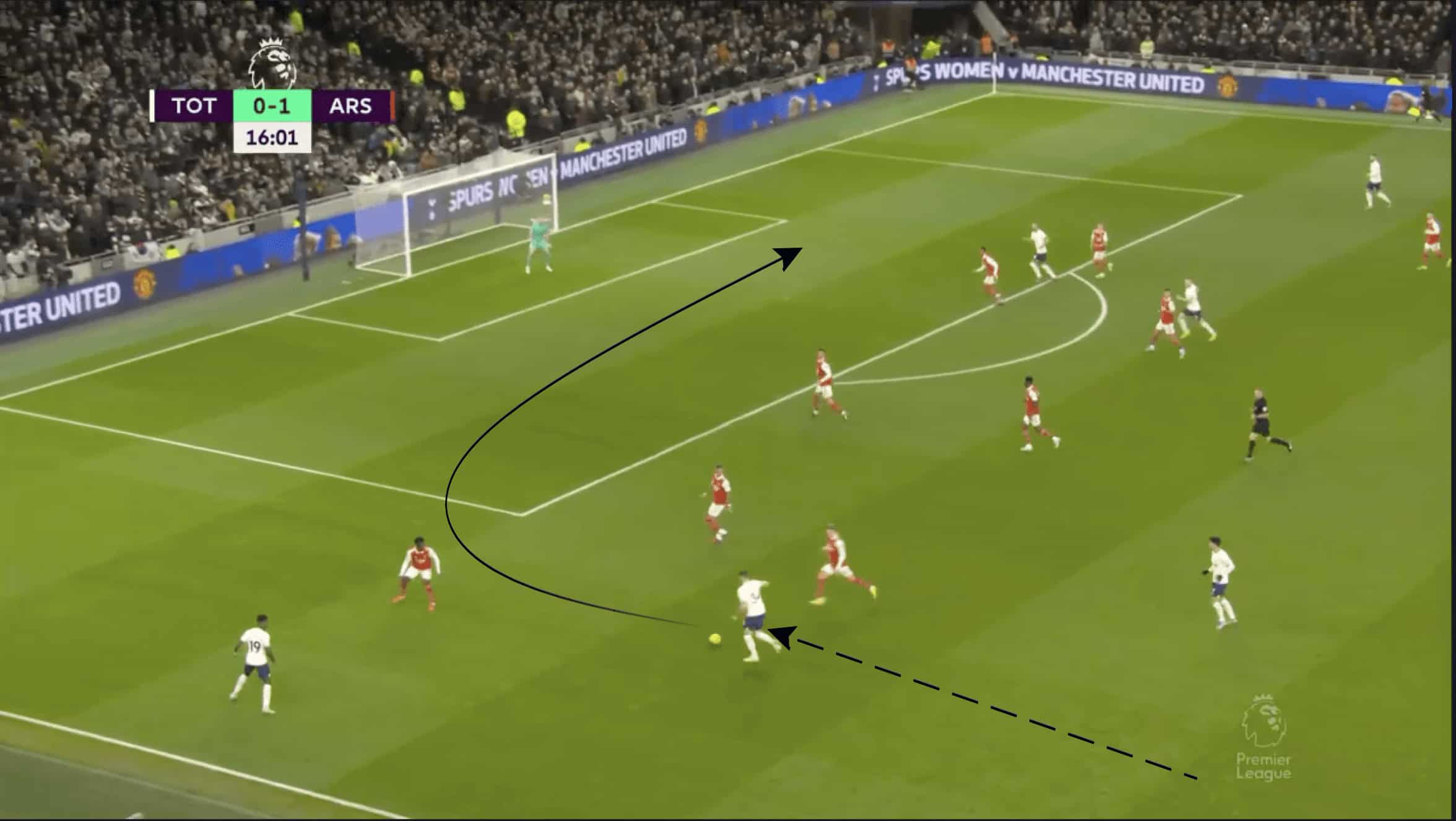
The wing-backs of the side were useful in progression, and as an attacking threat, and in the middle third and final third, they would push as far as the last defensive line of the opposition. An example of this can be seen below, with Matt Doherty in an advanced position as well as Sessegnon (off-screen) doing the same.

From these positions, due to the back line’s attention gravitating towards Spurs’ front three, the wing-backs would look to make runs behind the defence’s last line.

Defensive Phase
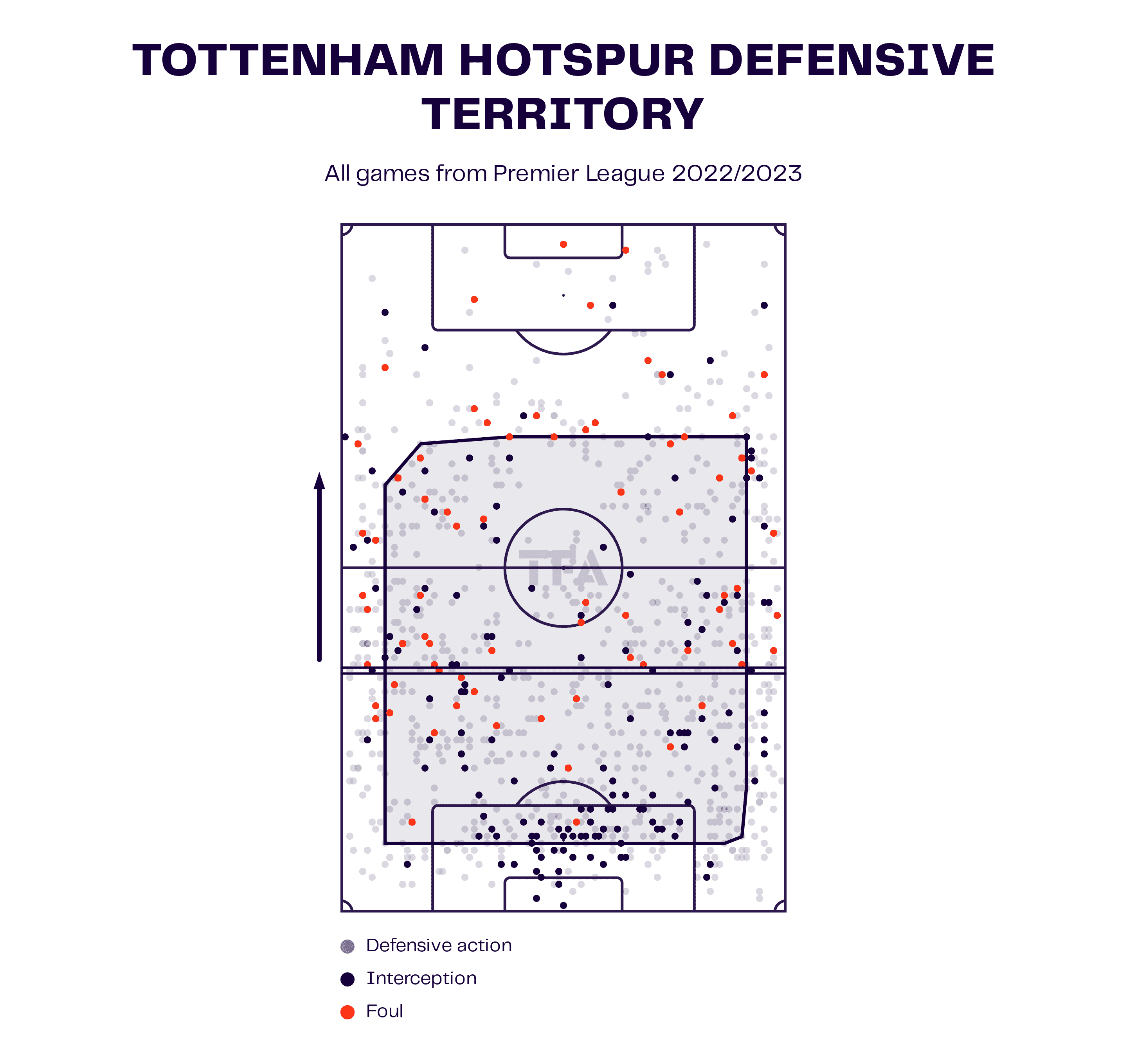
Spurs’ average line of engagement last season was slightly higher than a mid-block, with the majority of their defensive actions occurring in the wide areas and in their third. What is a cause for concern for the side is not only a large number of their defensive actions taking place within their third but also how few defensive actions and interceptions take place with the centre of the middle third.
One of the reasons for this occurrence is the relatively passive approach of Spurs’ second line of defence. The image below shows this example, with Thomas Partey receiving the ball in the midfield. From this position, both Højbjerg and Son look to prevent the passing option to the opposition player rather than one of them looking to press the Ghanaian.
Therefore, Partey had both time and space to play a long ball over the top that led to the game’s first goal. Without pressure from the first and second line, their relatively high defensive line becomes more susceptible to being exploited by long balls.
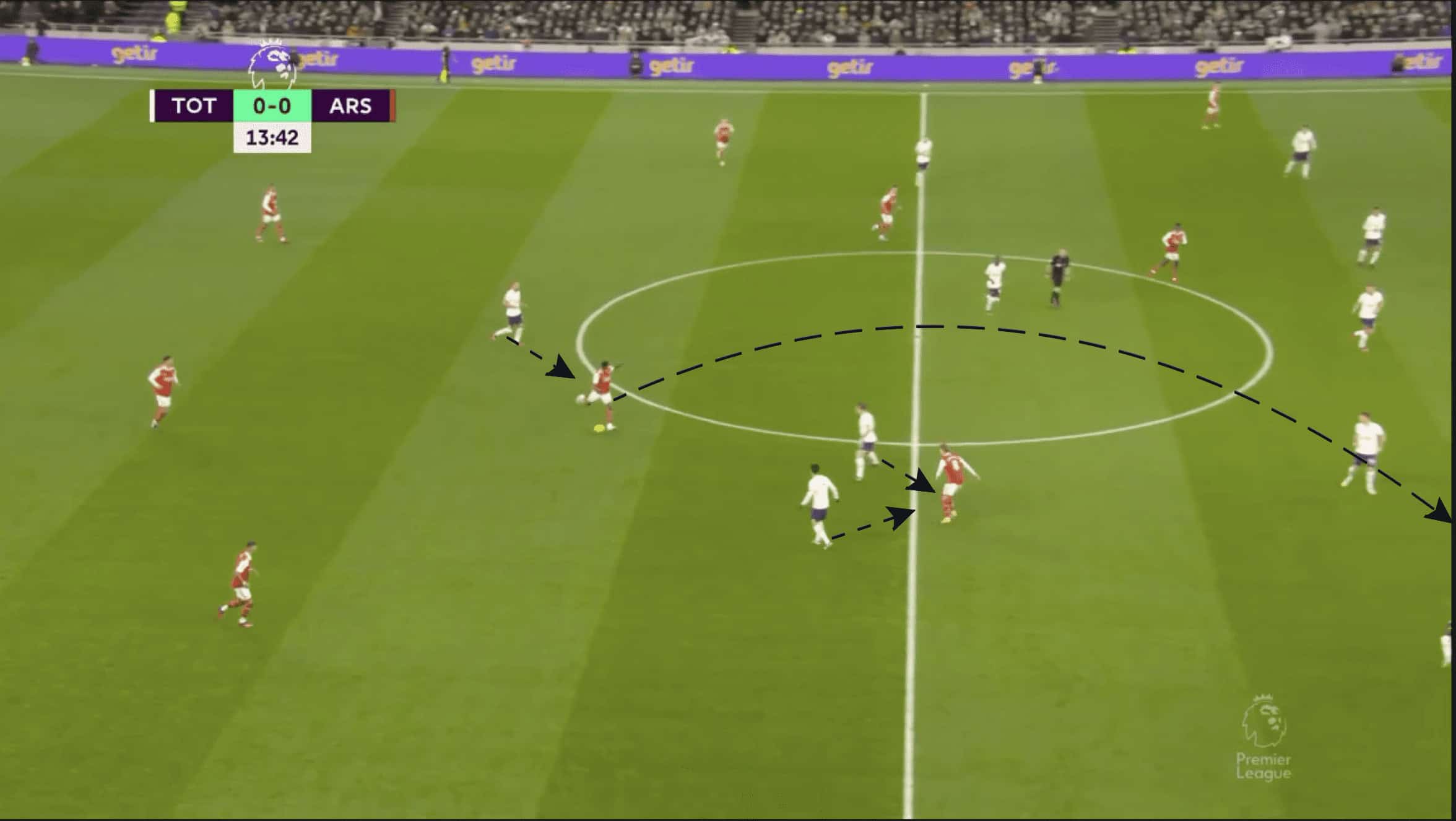
The image below shows Spurs, this time in a 5-3-2, experiencing the same problem. However, the problem is exacerbated this time by a need for more compactness in midfield. With only three players in the midfield in this example, the players in the second line of their defence would be more reluctant to press as it would leave exploitable space in the centre.
As a result, Spurs were caught between a rock and a hard place and due to the lack of pressure and their relatively high line, the opposition player could play a pass in behind the defence.
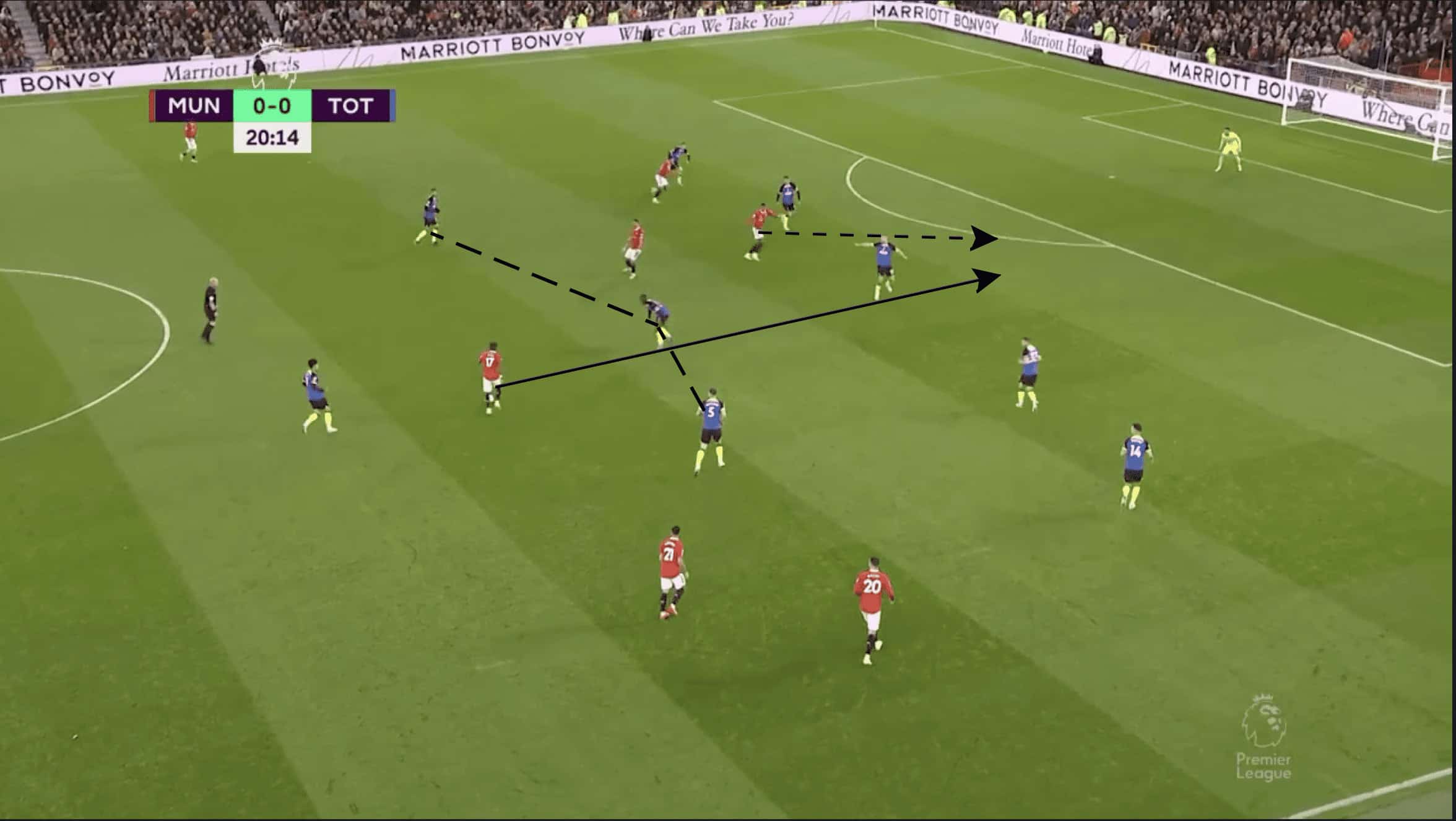
Transition
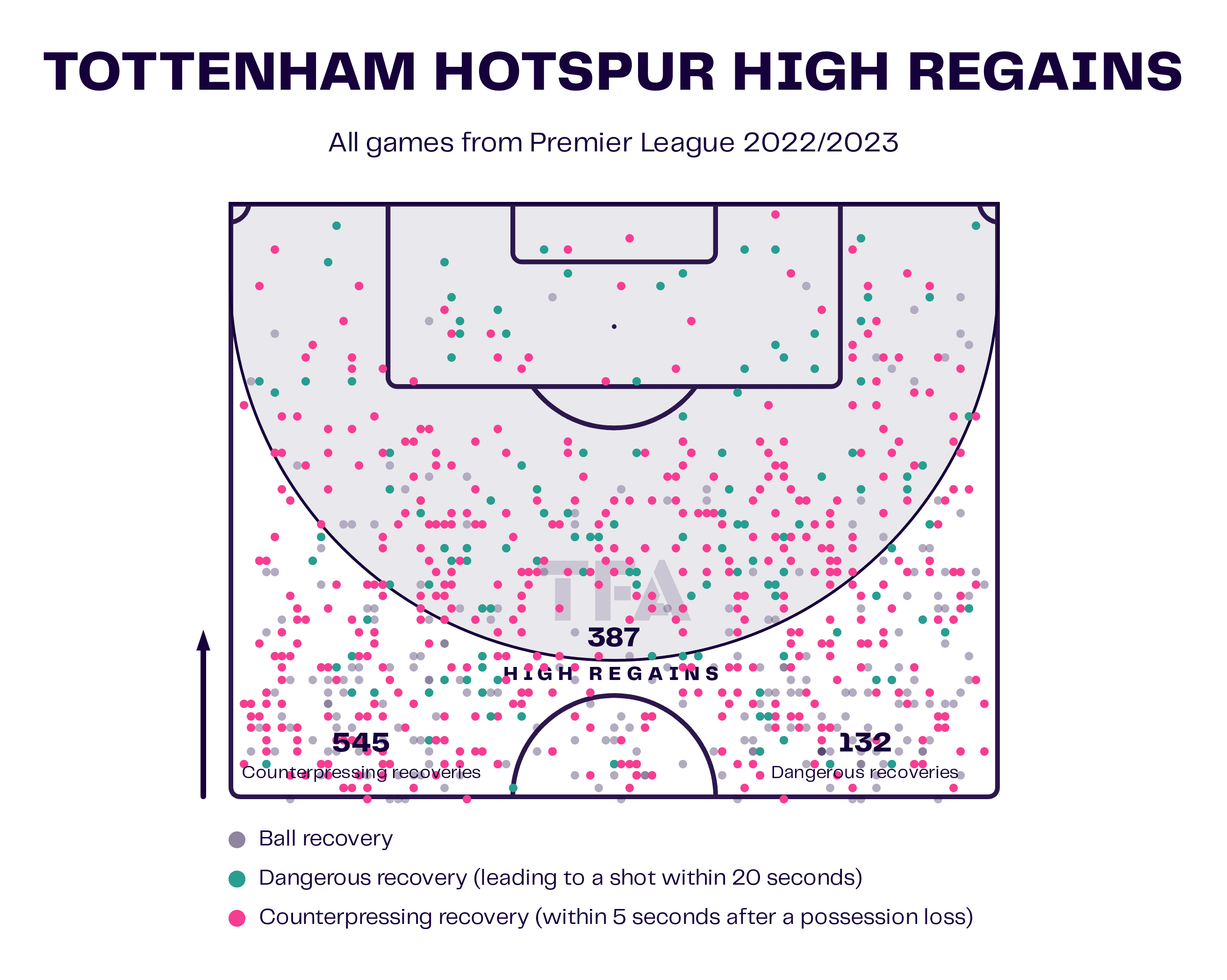
Spurs managed an impressive amount of counter-pressing recoveries last season, with 545. Generally, Spurs players react very well to losing possession, particularly in the attacking third.
This can be seen in the image below, where after a cross is cut out, Japhet Tanganga, Perišić as well, and Kulusevski all look to move towards opposition players either to challenge or potentially challenge for the ball.

However, at times, not all Spurs players in the vicinity of the ball react quickly to try and nullify the counter-attacking threat. This can be seen in the image below, where neither Doherty nor Kulusevski looks to apply pressure to the ball carrier or any of his teammates after possession is lost.
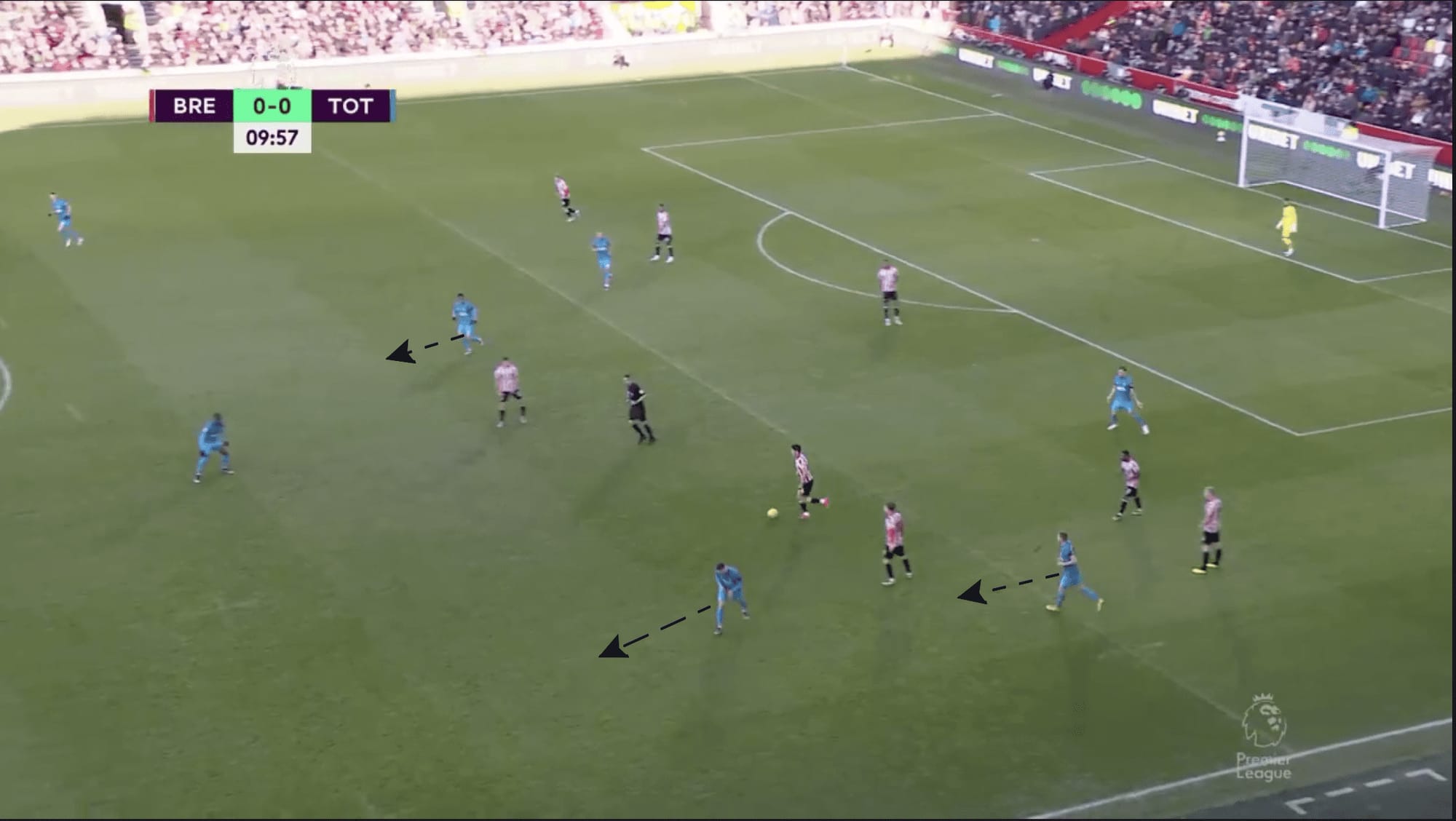
What will Postecoglou’s Spurs potentially look like?
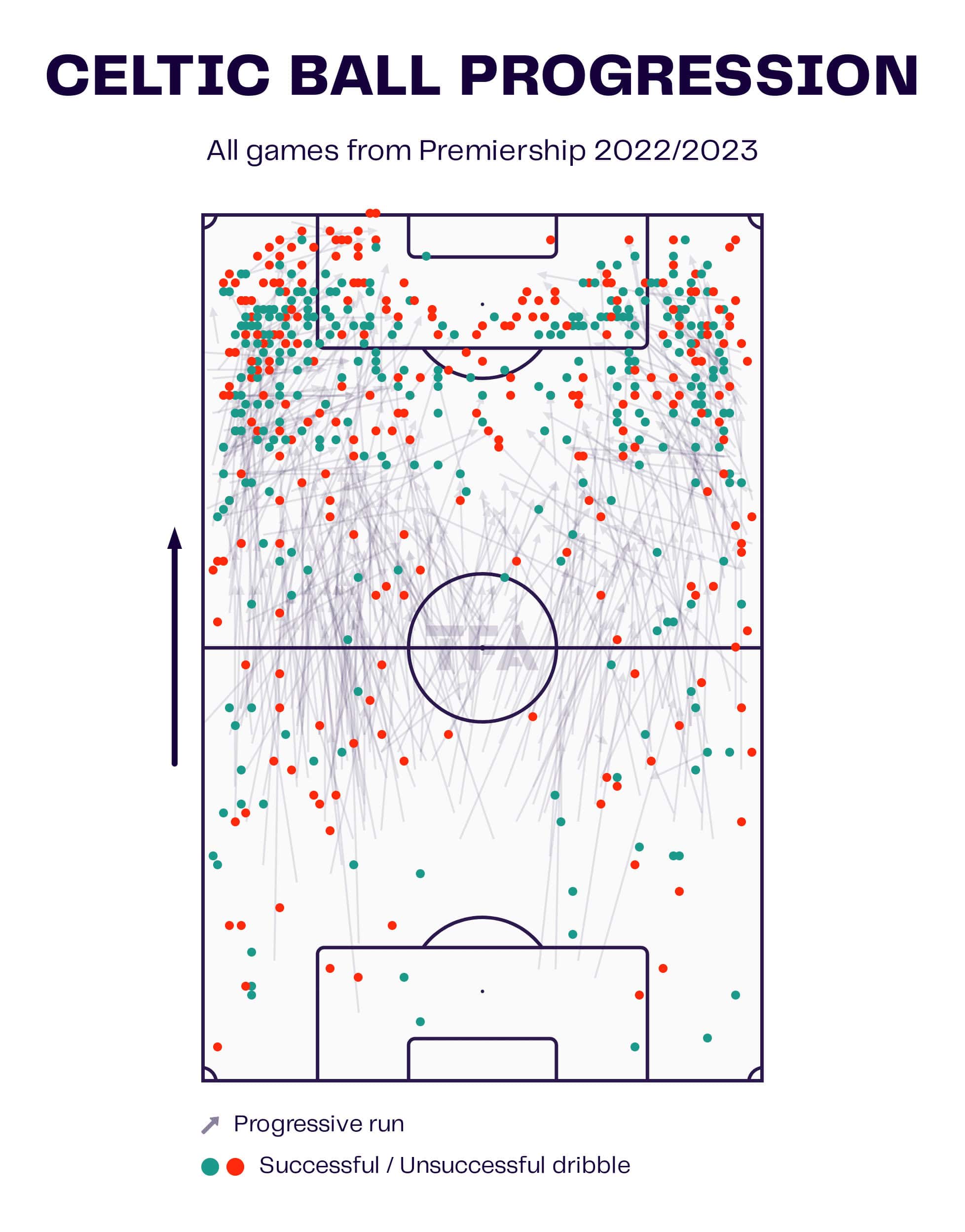
Akin to Conte’s Spurs last season, Postecoglou’s Celtic looked to progress the ball through the wide areas. As previously stated in the article, Spurs have an abundance of talent in the full-back positions, so the side will likely continually look to penetrate opposition lines down the flanks.
One of Celtic’s essential methods of creating chances was through overloads on the flanks. This can be seen in the image below, with Celtic creating a 5v4 overload in the final third. With Greg Taylor, the left-back, playing a pass and then looking to run into the space behind the back line before playing a cross into the box.
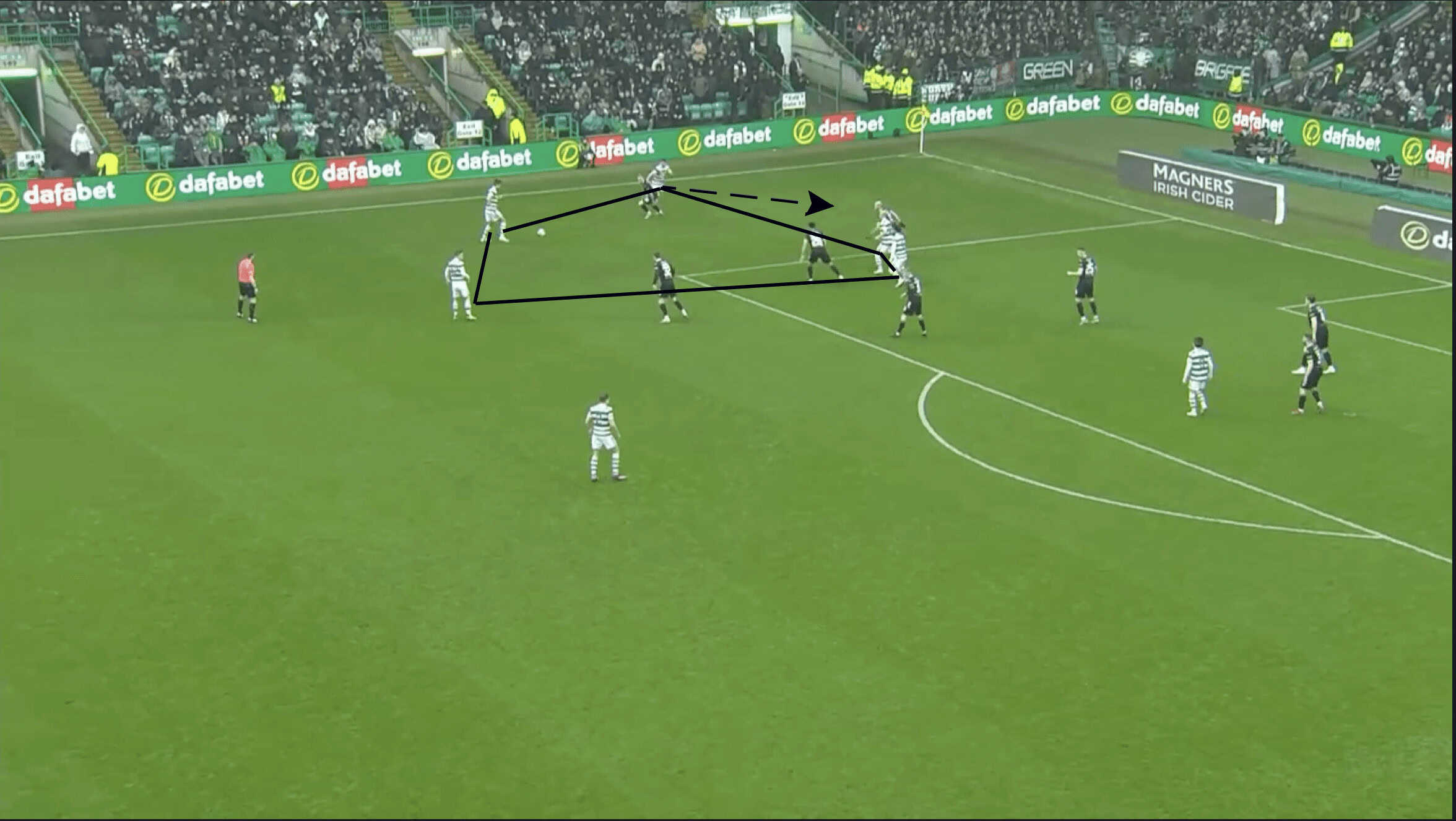
The critical conundrum that Postecoglou will face is how he uses his wing/full-back pairing at Spurs. At Celtic, rather than the full-backs keeping the width and advancing high up the pitch, the side’s full-backs inverted into the centre of the pitch, with the wingers staying high and wide. This can be seen in the image below as Alistair Johnston, the right-back, plays a pass to the inverted Taylor, who would then play a pass to the right winger.
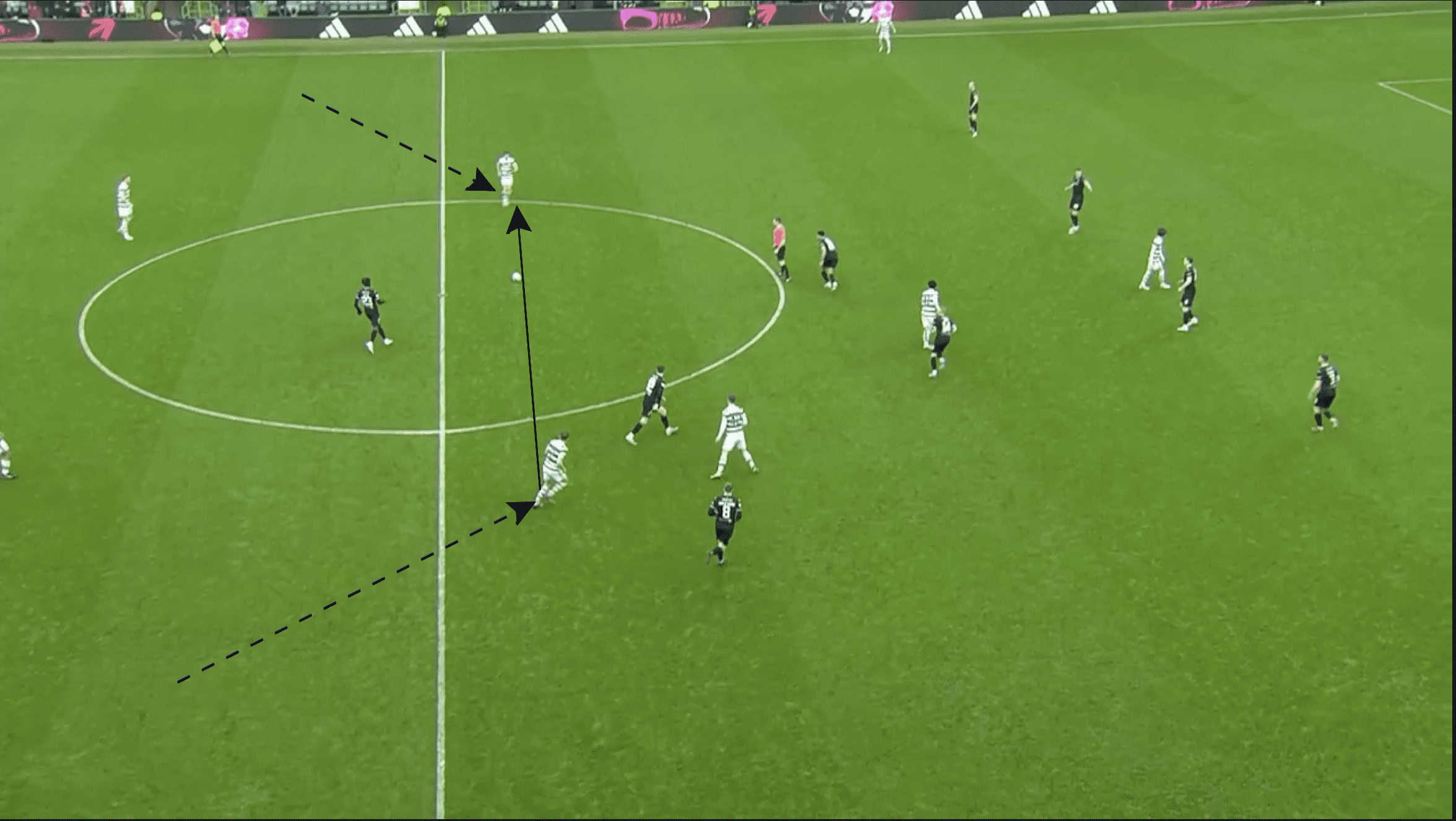
Due to Antonio Conte’s tenure in North London, much of the recruitment of full-backs was centred around their dynamism, speed, and ability to make attacking runs into the final third. Postecoglou may choose to alternate between inverting his wingers in order to play to the strengths of his full-backs or perhaps only one full-back inverting at a time.
The key question is how Postecoglou will look to use Harry Kane if the Englishman remains at the club.
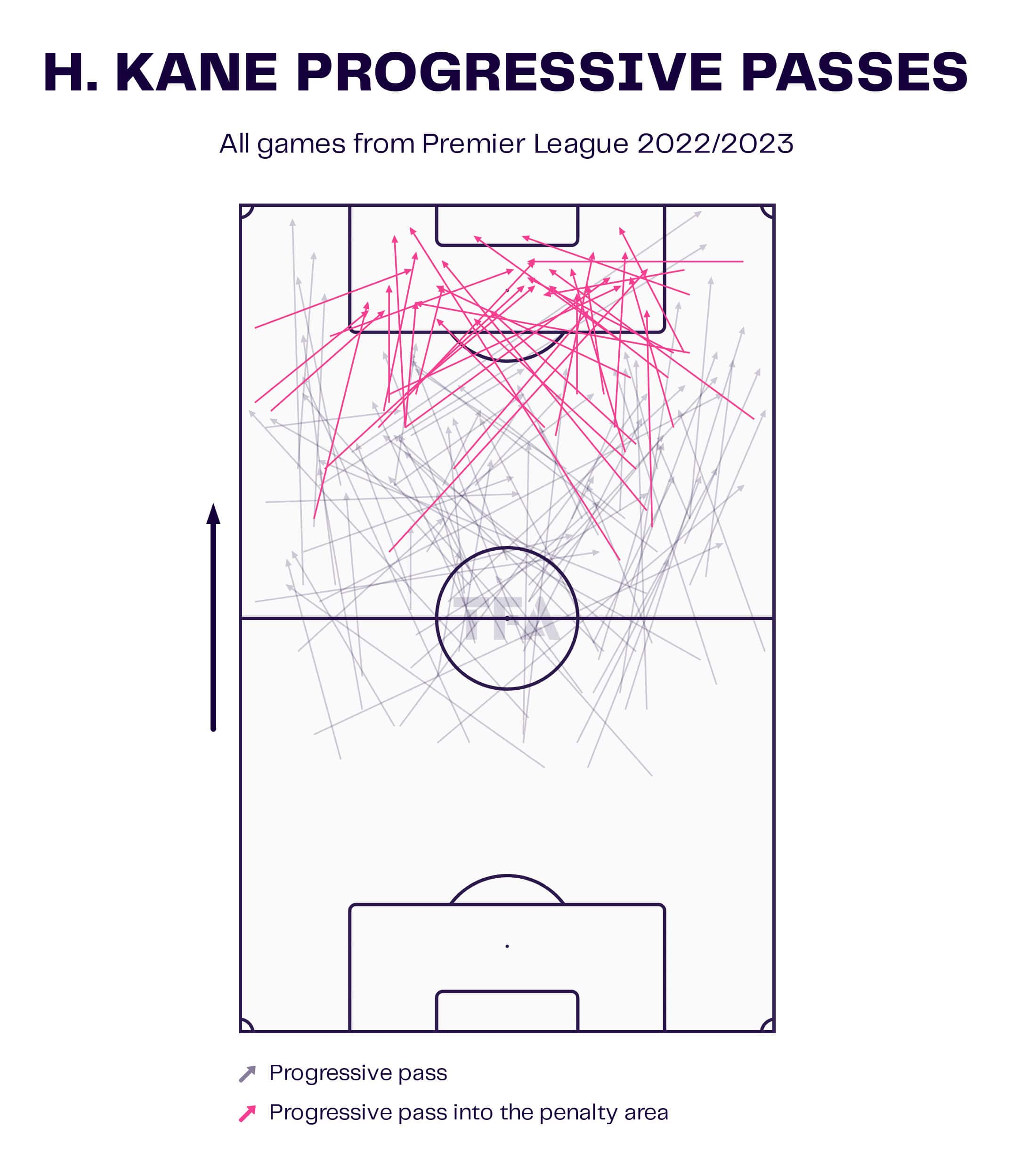
Kane’s ability to drop deeper and play balls into the final third has increased exponentially as his career has progressed. Although Postecoglou’s strikers did not drop deep at Celtic, instead staying on the last line, it is unlikely that the Australian would not look to utilise this aspect of the striker’s game. However, at this stage of Kane’s career, it may be wiser to let the striker be involved in less of the sides build-up and deep progression, as with the signing of Maddison, the side will have a player capable of progressing the ball forward from higher as well as deeper positions.
If Kane were to leave, Richarlison would suit Postecoglou’s style of play very well, with the Brazillian more comfortable playing on the shoulders of the last line of the defence. In addition to this, Son would also be the most likely candidate to play in the striker position, with the forward moving further and further away from the flanks and into the central role as his time at Tottenham has progressed.
Key Player: Heung Min Son
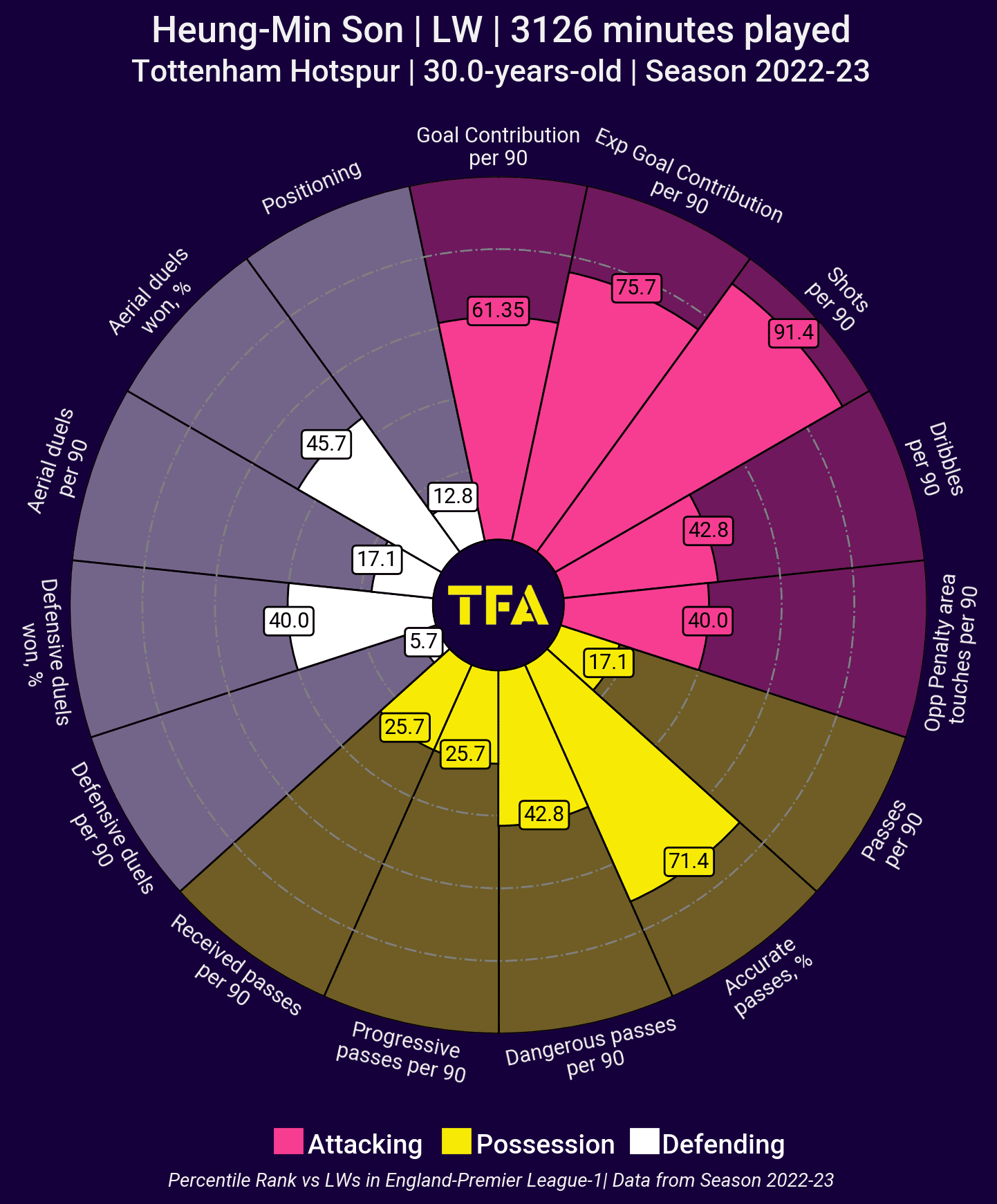
Either with or without Kane, Heung-Min Son will be the key player for the side this season. If Kane leaves, the side will heavily rely on the Korean for goals. Last campaign Son averaged 0.50 npxG and xA per game, which is a solid figure as it amounts to a goal contribution every other game. From the perspective of how Postecoglou looks to use his forwards, Son may enjoy a fruitful campaign
One to watch: Giovanni Lo Celso
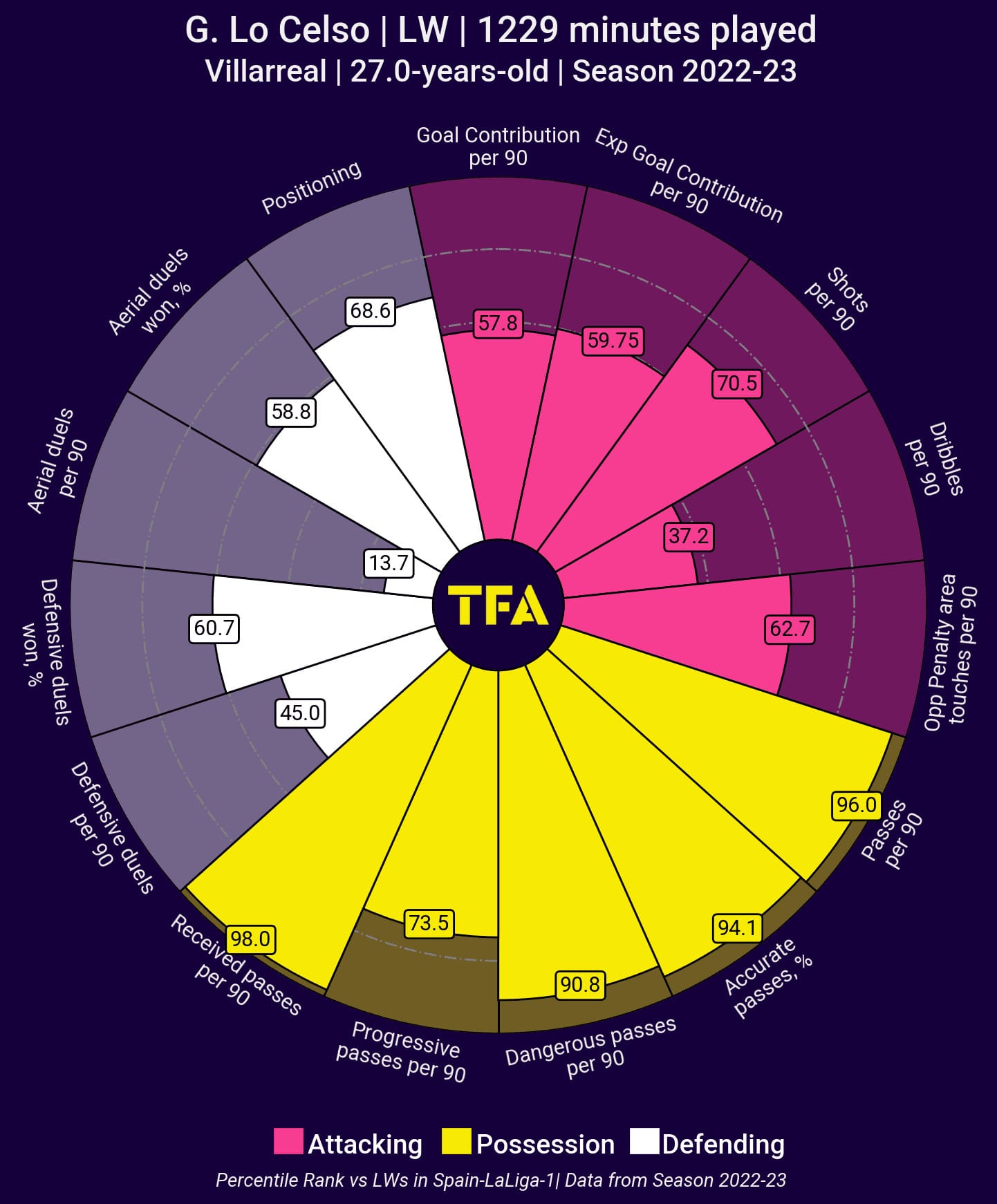
Coming off of the back of a successful loan stint at Villareal, Lo Celso can undoubtedly make an impact at Tottenham. The midfielder made 7.56 progressive passes per game and took 2.40 shots per game. Not only was he heavily involved in the side attack, but he also contributed defensively, making 3.04 tackles and interceptions per game
TFA Verdict: 9th
But it’s OK Tottenham fans, because at least you’ll be playing attacking football, right? Big Ange will bring his style to the table and that’s a very good thing. But, realistically, there are now better teams ahead of them in the league. At the time of writing, Harry Kane looks like he is off to Bayern but we’ve been here before. If they keep him, maybe 9th is underselling them. If they lose him, maybe 9th is too generous.





Comments